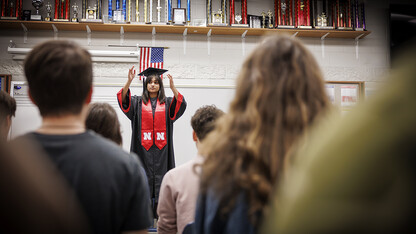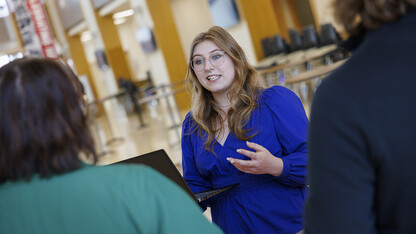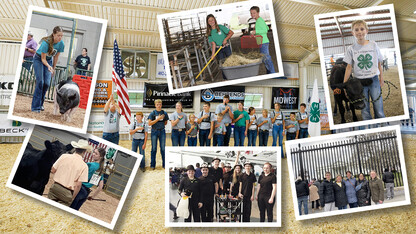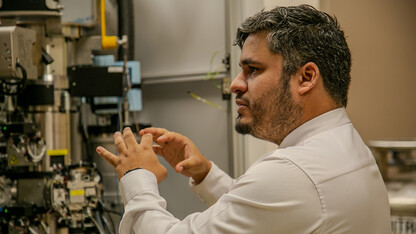· 7 min read
Nebraska in the national news: May 2020

Two University of Nebraska–Lincoln faculty members provided expertise related to the COVID-19 crisis for national news stories in May. The stories were among 35-plus featuring Husker faculty, staff, students, centers and programs during the month.
Eric Thompson, Nelson Professor of Economics and director of the Bureau of Business Research, was interviewed for a May 12 CNN.com article on why unemployment claims have been so low in Nebraska, South Dakota and Utah, relative to other states.
“The [COVID-19] impact here has been significant,” he said. “But that might be about half as large as nationwide.”
Primary industries in Nebraska include a large rail and trucking sector; farm equipment manufacturing; insurance; and finance.
“These are necessities that obviously are needed throughout the business cycle,” Thompson said.
The Omaha World-Herald also interviewed Thompson about how the Nebraska economy is faring amid the pandemic. The story was picked up by at least 11 Nebraska media outlets and more than 20 others nationwide.
Chris Bilder, professor of statistics, was interviewed for a May 13 ABC News article on the possibility of using group testing — the mixing of several samples for a single test — as a way to make up for COVID-19 testing shortages.
In a recent study, Bilder and colleagues determined that five samples mixed together was the right number and said that implementing such a method would result in using 57% fewer tests on average to reach the same number of individuals.
“Group testing will reduce the number of tests needed to determine who is positive or negative,” Bilder said. “It increases the overall testing capacity because with a fixed number of resources it will allow you to use those resources to test more people.”
Bilder has advised the Nebraska Public Health Lab on its group testing since mid-March. He, doctoral candidate Brianna Hitt and colleagues also have developed a new app to help determine which group test is most appropriate for specimens.
Live Science and the Omaha World-Herald also interviewed Bilder about group testing.
More coverage:
Stephen Spomer, entomology, was interviewed for a May 4 National Geographic article on the endangered salt marshes around Lincoln. He estimated that there are only about 250 Salt Creek tiger beetles left in the marshes. The species can’t be found anywhere else on Earth.
Judith Turk, School of Natural Resources, has authored a study showing that soil pores hold the key to stability for desert soils. Stories on the research appeared in the Environmental News Network, Phys.org and several other media outlets.
Karla Wilke, animal science, wrote a recent article on how cattle producers can adapt to the shortage of distillers grains caused by the shutdown of many ethanol plants amid the COVID-19 crisis. Western Livestock Journal published the article May 6.
Printing and Mail Services has been busy during the COVID-19 pandemic, printing, packing and shipping gift boxes for graduates and printing hand sanitizer labels. The projects were highlighted in a May 6 In-plant Impressions article. John Yerger, director of Printing and Mail Services, was quoted in the story.
Heather Richards-Rissetto, anthropology, discussed 3D visualization and her project “A 3D Exploration of Vision, Sound and Movement in the Ancient Maya City of Copán” for a May 8 article on the National Endowment for the Humanities website.
Byron Chaves Elizondo, food science and technology, was interviewed for a May 10 Women’s Health article on whether it’s safe to eat meat during the COVID-19 pandemic. “Because COVID-19 is not a foodborne illness, there is no reason to be concerned about getting the disease after consuming meat potentially contaminated with the virus,” he said. The story was picked up by Prevention and Pulse.
Nebraska Extension has launched https://disastercare.unl.edu, a website that allows municipalities, businesses or individuals with carbon materials to list their available products, and for livestock producers to search for needed materials. The carbon materials are used to safely compost the carcasses of livestock euthanized amid the COVID-19 pandemic. Articles about the website have appeared in eight Nebraska media outlets, Farms.com, National Hog Farmer and Pork magazine.
Jack Arterburn, beef systems specialist with Nebraska Extension, wrote a recent article on the Panhandle Public Health District’s suggestions for cattle branding amid the pandemic. BEEF magazine ran the story May 11.
ConstructionEquipmentGuide.com published a May 12 article on the College of Engineering’s $160 million construction projects. Dean Lance C. Pérez was interviewed for the story.
OmniSOC — a centralized hub of cybersecurity collaboration involving five Big Ten universities — won a 2019 Impact Award from Campus Technology in the IT infrastructure and systems category. Founded by Indiana, Nebraska, Northwestern, Purdue and Rutgers, OmniSOC is an initiative that works to quickly identify threats and initiate countermeasures.
Deirdre Cooper Owens, history, director of the Humanities in Medicine program, was the featured guest May 16 on the “Our Common Ground” program on Blog Talk Radio. She discussed minority health disparities and how black America is responding to the COVID-19 pandemic.
Jody Green, urban entomologist with Nebraska Extension, wrote a May 18 blog entry for Entomology Today on the eastern grape leafhopper.
Kevin Smith, political science, was interviewed for a May 19 Washington Examiner article on the possible importance of Nebraska’s 2nd congressional district in deciding the 2020 presidential race. “The scenario … where the split electoral votes in Maine and Nebraska could play a deciding role in determining who wins is far from unrealistic,” he said.
Allan Vyhnalek, Nebraska Extension educator, was interviewed for a May 19 Brownfield Ag News story on farmland cash lease agreements. Given the current economic situation, he said it might be time for landlords and tenants to discuss whether those agreements should be adjusted.
The U.S. Drought Monitor — produced jointly by the university’s National Drought Mitigation Center, the National Oceanic and Atmospheric Administration and the U.S. Department of Agriculture — was cited in a May 20 HuffPost article on weather disasters mounting amid the pandemic. Extreme droughts parched parts of northern California, Oregon, south Texas, some Great Plains states and the Northern Mariana Islands in mid-May, according to the monitor.
Matt Spangler, animal science, is leading a research team developing a web-based tool that will help cattle producers select the best bull for their herds. Called iGENDEC, for internet genetic decisions, the tool will give beef cattle producers a way to compare bulls. They can then make breeding decisions based on data available from research studies and multiple genetic evaluation systems. High Plains Journal published a May 20 article on the tool.
For their senior capstone project, a group of Husker computer science and engineering students collaborated with the University of Nebraska Medical Center’s Munroe-Meyer Institute on a virtual reality game designed to help children with cerebral palsy. Cerebral Palsy News Today published a May 20 article on the project.
A new study by Yuris Dzenis, mechanical and materials engineering, and colleagues has yielded breakthroughs in understanding the failure of high-performance fibers. The team’s analysis, and the new technique that yielded it, could inform the design of more-resistant, longer-lasting fibers. Phys.org and Technology.org ran May 20 articles on the research.
Brandi Sigmon, plant pathology, and her husband, Benny Mote, animal science, have built a corn-ear scanner at home to advance a study during the COVID-19 pandemic. They’re examining how 200 varieties of corn respond to various soil conditions, such as water stress and reduced nitrogen levels. Agri-View ran a May 20 article on the research.
A. Kelly Lane, a postdoctoral researcher in the School of Biological Sciences, has co-authored a new study titled “Undergraduate Student Concerns in Introductory STEM Courses: What They Are, How They Change and What Influences Them.” The Cornell Chronicle published a May 20 article on the study.
Chigozie Obioma’s novels “The Fishermen” and “An Orchestra of Minorities” were highlighted in a May 24 Quartz column by Rudolf Ogoo Okonkwo on teaching Afrodiasporic literature. Obioma is an associate professor of English at Nebraska.
In a new paper, Husker faculty members Patricio Grassini and Ken Cassman, both agronomy and horticulture, propose a four-pronged prioritization framework for funders to use as they distribute research dollars to agricultural scientists pursuing the goal of sustainable intensification. The Environmental News Network ran a May 26 article on the paper.
Daniel Ciobanu and Hiep Vu, both animal science, have received $1 million in grant funding to continue research that could lead to the development of vaccines and genetic-selection tools to fight some of the world’s costliest swine diseases. Stories on the researchers have appeared in KNEB, Feedstuffs, the Fence Post and National Hog Farmer.
Faculty, administration, student and staff appearances in the national media are logged at http://newsroom.unl.edu/inthenews. If you have additions to this list, contact Sean Hagewood at shagewood2@unl.edu or 402-472-8514. If you have suggestions for national news stories, contact Leslie Reed at lreed5@unl.edu or 402-472-2059.







